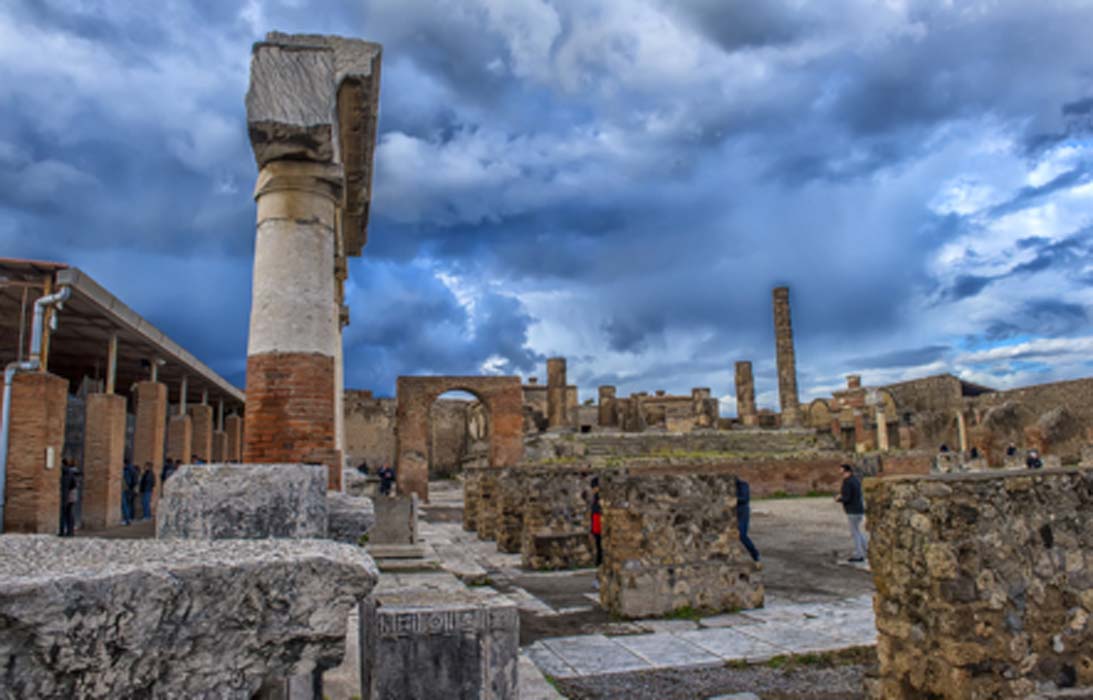Encased In Pompeii’s Volcanic Ash ’10 Unexploded Bombs’ Take Over Italian Headlines
In a conflict that killed almost 70 million people, it hardly comes as a surprise that archaeologists dig up so much left over junk. But events in Italy over the last 24 hours remind the heritage community that lingering threats from the war are still very real.
The ancient Roman city of Pompeii, 15 miles south of modern Naples, in the Campania region of Italy was in 79 AD buried under 13 to 20 feet (4 to 6 meters) of volcanic ash and pumice in the eruption of Mount Vesuvius. Pompeii is undergoing its most intensive new phase of excavation since the 1950s with some truly extraordinary finds coming to light, which according to the Italian daily , Il Fatto Quotidiano, include “10 unexploded bombs”.
Pompeii Bombed in World War II
In August 1943, during World War II, Pompeii was bombed by Allied Forces and while many of the 165 bombs dropped around Pompeii have been identified and cleared, beneath the soil of this unique World Heritage site, “ten have yet to be excavated”. Archaeologists stress the importance of identifying ‘where’ the remaining bombs are located to ensure the long-term future of the precious UNESCO World Heritage site.

Mount Vesuvius erupted in March 1944. Here, American B-25 Mitchell Bombers fly past Vesuvius, March 17–21, 1944. (Army Corps of Engineers archive / Public Domain)
An article in The Telegraph quotes Alessandro Pintucci, president of the Confederation of Archeologists who said, “while protection of the site is conducted on a daily basis for any damage caused by tourist traffic or the passage of time, we need to broaden our scope,” but he is quick to reassure “there is no risk for visitors”.
Just How Risky Are The Pompeii Bombs?
This incredible 170 acre (72.4 hectares) site is largely preserved under ash where organic remains, wooden objects, and human bodies entombed in the ash have decayed away leaving ‘natural molds' from which excavators make plaster casts bringing to life the terror of the last minutes of the volcanic catastrophe. The ‘Great Pompeii’ project, funded by the European Union and Italy, has recently unearthed more villas decorated with frescoes and mosaics, and yet more human skeletons trapped beneath rubble.

The Pompeii victims were encased in the volcanic ash. The Pompeii bombs are hidden in volcanic ash. (Hohum / CC BY-SA 3.0)
Dr. Massimo Osanna, the director of the Pompeii Archaeological Park told The Telegraph last night that “A bomb went off 30 years ago but that is impossible now under the regulations”. Under Italian law before any commercial or archaeological excavations can be carried out military engineers must first clear the site. Il Fatto said, “there was no sign of official documents for the location of at least 10 bombs” but Mr. Osanna said, “two years ago, we spent two months actively monitoring and clearing Zone 5 ( or Regio V) where the Great Pompeii project is taking place”.
He admitted that it was difficult to know “how many World War II bombs were still buried” and he said that he would welcome “any input from the British Air Force to help determine where they were located”.
- Supervolcano That May Have Wiped out Neanderthals Comes to Life Again
- Unearthed Brooch Tells of the Nazis’ Abuse of Ancient Norse Runes to Spread Their Dark Ideology
- Skeleton Found in Pompeii Belonged to Child Seeking Shelter from Deadly Volcanic Eruption

Aerial view of Pompeii with Vesuvius in the background. (ElfQrin / CC BY-SA 4.0)
In a statement released on Sunday Pompeii officials stressed “there could be unexploded bombs beneath the soil in the area that has not been excavated but the total number is hypothetical” and he added “there was no risk” for excavators or tourists.
There Are Unexploded Bombs Everywhere - Yikes!
In 2013 CNN reported that a 200 pound (91 kilogram) unexploded bomb was discovered less than 20 feet from a train track near Berlin’s main station causing 840 people to be evacuated from central Berlin and schools and hotels to be shut down. German aviation authorities put planes in holding patterns above the city as bomb squads attempted to defuse the Soviet-made device.

Like the Pompeii bombs, unexploded World War II bombs are everywhere. This one was found in the Rhine near Koblenz in 2011. (Schaengel / CC BY-SA 3.0)
And this German incident offers a hint at the challenges fast approaching the Pompeii archaeologists, for once they do actually find the bombs, that is when the fun and games begin. Relating to the German railway bomb a National Geographic article, at the time, stated that even once unexploded bombs are located, things start to get “even worse as the unexploded bombs decay and get harder to defuse”.
Depending on the state of the ten unexploded bombs it might turn out to be in the “Mission Impossible” zone of complexity.
To finish this news piece I will refer to an observation published in an article in the Irish Times which points out a bizarre coincidence; “the 165 bombs were dropped by the allies in Pompeii on August 24th, 1943, the same day of the year in 79 AD in which the ancient city of Pompeii was destroyed”. A coincidence? Or an explosive political message?
Top image: Unexploded Pompeii bombs from World War II may be hidden in the ancient ruins. Source: Evdoha / Adobe Stock.
By Ashley Cowie



















